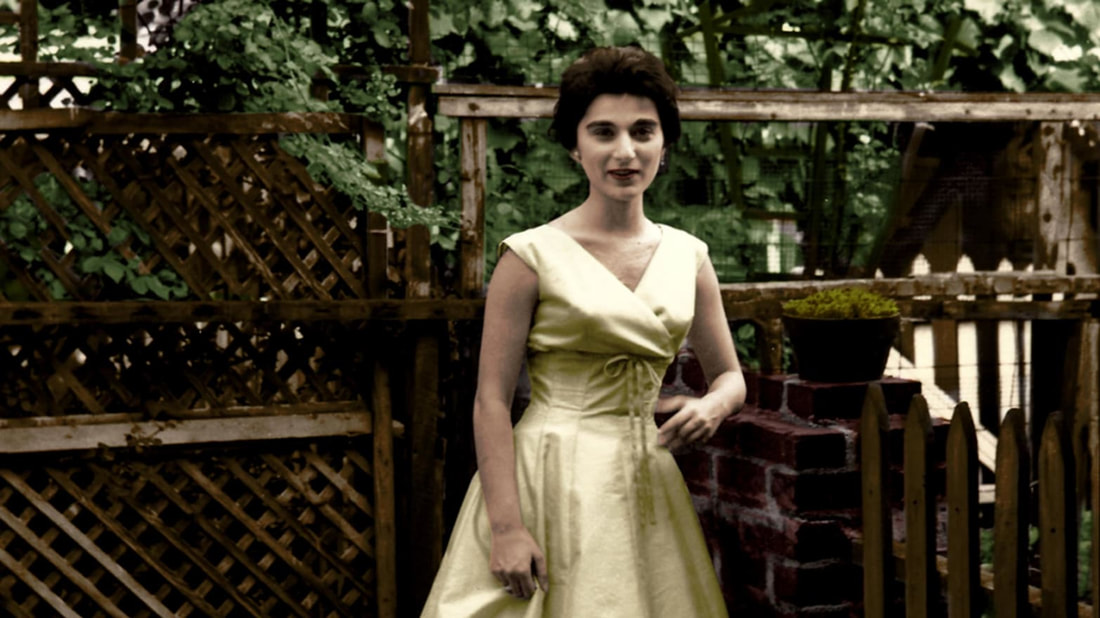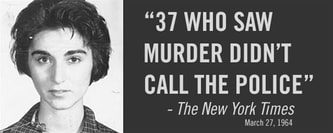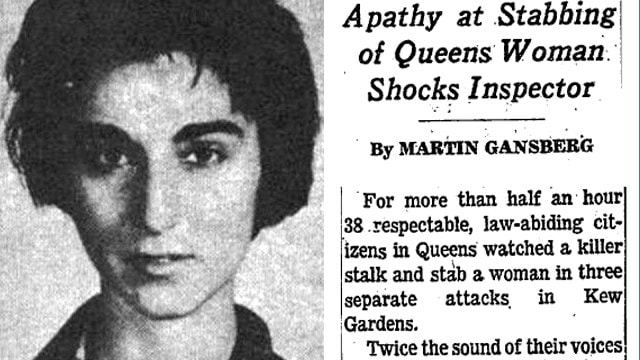|
In 1964 there was a brutal double attack on a young woman named Kitty Genovese that resulted in her death. The attack was not covered in the press for around two weeks and when it finally got some ink, it was grossly misreported. This crime and the behavior of witnesses reported by the newspapers led professionals in the psychology community to conduct a number of experiments to determine what went wrong in the response of bystanders and why people seem to be so reluctant to help in such situations.  Kitty was born Catherine Susan Genovese on July 7, 1935. She was kind of a wild Italian girl at times with a confident attitude and a pleasant disposition. She lived with her parents and then her grandparents all the way up until she got married in 1954 at age 29. But, the marriage was short lived and was annulled towards the end of that same year. She moved in her own apartment in Brooklyn and worked clerical jobs, which she didn’t like, until the late 1950s when she found a job as a bartender. While working behind the bar, she also made money on the side as a bookie. Unfortunately, she got busted for this in 1961 with her girlfriend, Dee Guarnieri. They each had to pay a $50 fine and Kitty lost her job. She quickly got another bartending job and soon she was managing the place because apparently, the owner was hardly ever there. This allowed her to work a lot of overtime. She saved as much money as she could and planned to open her own Italian restaurant.  On March 13, 1964 at about 2:30am, Kitty left Ev’s Eleventh Hour Bar where she worked and headed home to her apartment that she shared with her girlfriend at the time, Mary Ann Zielonko, whom she met sometime in 1963. Genovese arrived home at around 3:15am. She parked her car in the apartment complex parking lot which was about 100ft from her apartment building’s front door. She exited her vehicle and began to walk to her building. At this point a man with a knife approached her. When Kitty saw him she started running towards her building and the man gave chase, running after her. He quickly caught up to her. Once he got her, he rapidly overpowered her and thrust his blade into her back twice. Kitty screamed in pain, “Oh my God, he stabbed me! Help me!”  A number of people heard her cry out but, only a few identified the sound as a cry for help. One of her neighbors, a gentleman by the name of Robert Mozer, even yelled at the attacker trying to scare him off and it worked. Once Mozer hollered, “Let that girl alone!” the attacker ran off leaving Genovese seriously injured and to fend for herself. She made her way toward the back of the building at a snail’s pace. At this point, she is bleeding profusely and quickly losing strength. She is also now in a more secluded area, out of the view of any witnesses. This is when witnesses say they saw the perpetrator enter his vehicle and leave the scene only to return 10 minutes later. This time he was wearing a hat with a wide brim. This allowed him to obscure his face from any onlookers. He began to carefully and systematically search the area for Kitty. Eventually, he found her. She was lying nearly unconscious in a back hallway at the rear of her apartment building. To her heartbreak and dismay, once she had reached the building, a locked door had forbidden her from entering to safety. Now out of earshot and eyesight of any and all would-be onlookers good samaritans, the attacker proceeded to stab Kitty Genovese several more times. Then, in a very cold and brutal act of savagery, he raped her as she lay there bleeding to death and crying. Once he was finished defiling this terrified young woman, he added insult to injury by taking $49 from her wallet and then bolted off like a coward. The vicious attacks on Ms. Genovese spanned the period of about a half an hour, during which time defensive wounds suggest that Kitty put up a hell of a struggle as she fought the assailant for her life. In the end, one of Kitty’s neighbors, a Ms. Sophia Farrar, found her a brief time after the second attack and held Genovese in her arms until emergency services arrived. Kitty Genovese was put in an ambulance at 4:15am. She died on the way to the hospital.  Almost a week later, on March 19, a guy by the name of Winston Moseley was picked up for being suspected for robbery when the cops found a TV set in the trunk of his white Chevrolet Corvair. At the time, a detective remembered that a white car had been reported as being seen leaving the scene of the Genovese murder just a week before. Once the interrogation started, Moseley admitted not only to killing Kitty Genovese but, also to killing two other women, Annie Mae Johnson, who he had shot and burned to her death in her apartment a few weeks prior and Barbara Kralik, who was murdered in her parents’ home in July the previous year.  Moseley had been sitting in his car when he spotted Genovese driving home. He had seen her as she was stopped at a stoplight. He began to follow her home and when she arrived and parked her car, he parked his car a little ways away, armed himself with his hunting knife and began to pursue her on foot. Two weeks after the Genovese murder happened, it FINALLY made headlines. If it hadn’t been for the NYPD Commissioner making a comment about the murder to an editor of the NY Times, this story might not have made the papers hardly at all. However, when the papers did get around to reporting the horrifying tragedy, they got it all kinds of screwed up. Whether it was for the purpose of selling papers or whether they were just that bad at getting the facts straight, both are something that I can make a case for either way.  The papers stated that thirty-seven people stood by and watched this sadistic attack go down and nobody did anything to help. Once word of THAT got around people were even MORE horrified with what had happened. It’s bad enough that a young lady would lose her life in such a callus and heinous way but, for all those people to just stand by and watch, to look out their windows and stare and do nothing. To open their doors and see a woman in such desperate need of help and turn around, close the door and go back to what they were doing before they heard the blood curdling screams. Another thing in the news report that people seemed to really focus on was a quote of a witness that stated “I didn’t want to get involved.” Many saw this as a clear representation of the decaying sense of care from one common human to another and the lack of empathy throughout large cities across the country, specifically New York. In reality, there were at least two phone calls to the police, a man that yelled at the assailant and a woman that held the victim until help arrived. At the time this incident happened there was no established centralized emergency services number, so 911 didn’t exist. What people did was dial ‘0’ for the Operator and ask for the Police, hoping they weren’t too busy to transfer you in your time of need. Hardly an efficient way to render aid to someone who is having a heart attack or being stabbed several times and raped in the back of an apartment building. In 1968, 911 officially became the national emergency services number for the United States. And it would not have happened had it not been for the Kitty Genovese murder case. Research on the behavior of the witnesses was also a result of this case. It came to be known as “the bystander effect”. The most basic definition of this social psychological phenomenon is the more people that are around when an emergency situation presents itself, the less likely those people are to render aid themselves or make effort to seek aid for the person in need. Amazingly, there is a lot more psychologically to it than just how many people are around. Research found that a number of factors go into the decision making process of whether or not to become someone’s hero in their time of despair. Some of the elements that influence the decision are things you would naturally think of, others not so much. For instance, not only does the number of people around the bystander affect whether or not they will help (or even consider the event an emergency, we tend to base OUR reactions off of the reactions of others when we are in groups so, if everyone in the group doesn’t acknowledge an emergency, chances are we won’t either or will take longer to step up and do so) but, whether or not we have things in common with the person in need can play a part in it as well. Say you are at a pro football game. The majority of the crowd is in the home team’s jerseys, t-shirts and game gear. The fans that support the visiting team are proudly sporting their jerseys and such as well. You have a great time and your home team wins. You’re feeling happy and lighthearted as you walk to the parking lot to leave. As you exit the stadium, you see a man and a woman. They are down on the ground. There is some stumbling, some struggling to get up, a few unintelligible words and arms flailing. You see spilled beer and empty cups. And you see the opposing team’s jerseys. As you as you walk by, what do you do???  If you are like the majority of the human race, you would most likely look with curiosity, perhaps strain to hear or even take your phone out to video the incident and continue walking. Many would assume that this was likely two drunk fans that after watching their team lose for over three hours, probably knocked a few too many back and now these chuckleheads can’t stand up on their own. It might never even occur to you that this could be a domestic dispute or an intoxicated woman in trouble trying to flee or even a man being attacked by a sloshed date that he wishes he had cancelled. However, had they been wearing the home team’s jerseys we would have been much more likely to at least stop and watch to see the event unfold, to see if there was an emergency, to see if help was needed. We would have seen that jersey as a symbol of a teammate, a comrade, a friend. The opposing jersey would have psychologically represented an enemy. After all, we did just watch over three hours of a total sanctioned war being played out on a field in the model of a true just society. (Look, football is the model for true justice if you think about it. I mean in theory, people. There’s a specific set of rules and everyone knows them. There’s people there to monitor that the rules are followed. And the moment someone breaks the rules, a swift and just punishment is handed out and it’s the same for that infraction pretty much every time. JUSTICE.) Likewise, we are more apt to help people we feel have similar likes, lifestyles, opinions, etc. Especially psychologically as we seem to always have this “us vs. them” mentality when it comes to difference of opinion. Next, people are always afraid to “get involved”. It can be for a number of reasons. At the time of the crime people are often scared of being hurt themselves or that their aid will hinder rather than help. (We rarely think that we are qualified to help in an emergency.) In women’s defense classes they sometimes teach to yell, “Fire!” instead of, “Rape!” because people are so much more likely to come to look at the horrors of a blazing person or building and so much less likely to intervene on a violent sexual assault. (That’s messed up, seriously. That’s just plain horrible and disgusting, thinking that carnage garners more curiosity than cries for help garner aid. Humans can be so heartlessly morbid sometimes.) People are often afraid of the police and don’t want to talk to them. We often get nervous around police or maybe look at them a little sideways, perhaps. They also don’t want to have the police coming back to their home over and over to ask questions, thinking it looks bad to neighbors. They don’t want the publicity of their names in the papers or their faces on the news and these days, everything is online first. They are reluctant to be part of a trial. That’s a big one. Everyone knows that when you become a witness for a trial, your opposing side is going to try their hardest to discredit you and rip you to shreds. It takes a lot to sit in that witness chair and go through the criminal event, what you know and then for THEM to go through what they now know about you. And as a witness, yeah your side can object but, two things you gotta know. One, the jury still hears it and remembers it, even when they are told to forget it and two, there are no WITNESS shield laws (like the rape shield laws that protect rape victims) that protect you from being exposed, exploited, hounded, followed, vilified, embarrassed, whatever they want to do to make you look like a bad witness. Now, I don’t want you to take this as set in stone. As with pretty much all research, for every study showing one conclusion, you can find one showing the opposite. Such is true for this topic as well. There are studies in later years that have concluded that the number of people around when an emergency occurs does NOT affect whether or not someone will help. I would like to point out though, that these studies were done after the year 2000 and all research concluding the former was done prior to pretty much 1990. In addition to all of that, despite the facts being proven to be different than that of the story in the papers, that exaggerated tale is STILL the account that is used in psychology textbooks everywhere to this day. It is used more as a parable now rather than represented as fact but, that is RARELY noted in the texts and students are led to believe the fictitious account is the truth. We live in a different time now. In the 60s, nobody was opposed to minding their own business and even the President was given latitude with his personal indiscretions not being printed in the daily paper or read on the morning news like they are now. In fact, White House aides used to call reporters and tell them things like you’re gonna find out that the President was out at a certain hotel this evening with a certain young lady. He’d really appreciate it if you didn’t print that tomorrow and for your discretion he’ll give you exclusive access to BLANK, or whatever the appropriate offer of thanks would be. Nowadays, there is no reasonable expectancy of right to privacy with all the technology we have. Privacy is a reasonable right that has been turned into a variable myth. As such, our behavior out in the open changes as well as behind closed doors. In the wake of so many mass shootings and the rise of outward violence hitting our streets once again, we tend to be somewhat desensitized to horrors that confront us every day. In fact, I just found out today that a man who murdered one of my close friends and my friend’s girlfriend in high school, and was acquitted, was just found guilty of five robbery/homicides in my city that he committed almost five years ago. I had been following the case rather closely hoping he wouldn’t escape justice this time. And yet, the news was presented the same way the rest of the news is presented, with the same emotional void or fake emotion, the same lack of realization that there are real people behind these headlines, real victims. We all want to think that we know what we would do or how we would react in certain high risk/high stress situations. And while we HAVE grown in some ways as a society, we still lack the general cohesiveness that pushes us to look out for a fellow stranger in addition to our family, friends and loved ones. As these mass shootings and other horrific events continue to take place we see that there ARE people that are willing to help people they don’t know, willing to put themselves in harm’s way to render aid in times of need and emergency. And we see that even within an average, everyday person can emerge the greatest of heroes. People who don’t care what is viewed as right or wrong, what is being filmed or not, and what credit they would get or what fame would be given. They help because they are there, they can and someone needs it. And when it comes down to it, isn’t that really what it should be about?
0 Comments
|
AuthorThe Countess of the Crypt Archives
February 2024
Categories |
Proudly powered by Weebly

 RSS Feed
RSS Feed